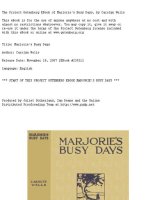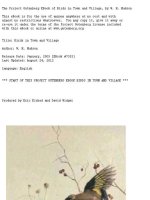The Project Gutenberg EBook of Explanation of Terms Used in Entomology, by John. B. Smith potx
Bạn đang xem bản rút gọn của tài liệu. Xem và tải ngay bản đầy đủ của tài liệu tại đây (3.55 MB, 912 trang )
The Project Gutenberg EBook of Explanation
of Terms Used in Entomology, by
John. B. Smith
This eBook is for the use of anyone
anywhere at no cost and with
almost no restrictions whatsoever. You may
copy it, give it away or
re-use it under the terms of the Project
Gutenberg License included
with this eBook or online at
www.gutenberg.org
Title: Explanation of Terms Used in
Entomology
Author: John. B. Smith
Release Date: September 23, 2007 [EBook
#22748]
Language: English
*** START OF THIS PROJECT GUTENBERG EBOOK
TERMS USED IN ENTOMOLOGY ***
Produced by Jon Richfield
EXPLANATION OF TERMS
USED IN ENTOMOLOGY
PREPARED BY JOHN B. SMITH,
Sc.D.
Professor of Entomology in Rutgers
College, Etc.
PUBLISHED BY THE BROOKLYN
ENTOMOLOGICAL SOCIETY
BROOKLYN, N. Y.
1906
PRESS OF THE NEW ERA PRINTING
COMPANY
LANCASTER, PA.
{
Scanner's note: This book is about a
century old at the time of scanning. I
found it in the discard pile of a local
university library. I find the book to
be of exceptional historical interest in
the insights it gives into the
development of early modern
entomological science. It also is of
practical value as a source for terms
that are obscure to modern users
because they are no longer current.
Such works are extremely difficult to
rid of all errors, so treat any really
suspicious looking passages with
reserve. I have avoided the use of
non-alphabetic symbols as far as I
could, for example Greek letters and
male, female and hermaphroditic
symbols, but if you encounter
difficulties, those might be the
source. Also, the colour table at the
end is not really much good for
anything beyond general
impressions; not only are the paper
and ink old, but between my scanner
and your screen or printer, there is
room for too much misinterpretation
of precise colour, for anyone to take
it seriously.
}
FOREWORD. *
EXPLANATORY. *
A *
B *
C *
D *
E *
F *
G *
H *
I *
J *
K *
L *
M *
N *
O *
P *
Q *
R *
S *
T *
U *
V *
W *
X *
Y *
Z *
ADDENDA. *
EXPLANATION OF PLATES. *
PLATE 1. Structures of the External Body
Wall. *
PLATE II. Structures of Head, Mouth,
Thorax & Genitalia *
PLATE III. Venation According to the
Comstock System. *
COLOR PLATE. *
FOREWORD.
When, some time since, in
consequence of continuing demands,
the Brooklyn Entomological Society
resolved to publish a new edition of
its Explanation of Terms used in
Entomology, and entrusted the writer
and two associates with the task of
preparing the same, it was believed
that a little revision of definitions, the
dropping of a few obsolete terms and
the addition of a few lately proposed,
would be all that was necessary. It
was to be a light task to fill idle time
in summer, report to be made in fall.
Two years have passed since that
time; the associates have dropped by
the way; the manuscript contains five
times the number of terms in the
original "Explanation." and if it is
published now, it is not because I
believe it to be complete; but
because I do not believe it can be
made complete except as the result
of criticism and voluntary addition by
specialists throughout the country.
It is twenty-six years since the original list
was published and nothing can better
illustrate the advances made than a
comparison between the old and the new
Glossary. No one realizes better than I the
fact that as students have increased in each
order, each has followed an independent
line of research, absolutely without regard
to the work done elsewhere. In
consequence, we have several terms for
the same thing in many cases and, in an
equal number, several meanings to the
same term. As no one man can now-a-days
cover the entire field of Entomology, it
goes without saying that I was compelled
to rely partly upon books and partly upon
the good nature of correspondents to make
the work even approximately complete.
The first notable contribution came from
Professor Justus W. Folsom, of Urbana,
Illinois, who sent me over 2000 cards of
terms collected by himself and his
assistants, and these added materially at
the beginning of the work. A number of
correspondents were good enough to send
in lists of terms in Coleoptera,
Lepidoptera, Orthoptera, Hemiptera and
Neuroptera, and to refer me to literature
where explanations of other special terms
could be found.
After the cards were so far advanced as to
warrant a preliminary manuscript, Dr.
Philip P. Calvert of the University of
Pennsylvania. Mr. Nathan Banks of
Washington, D. C., and Mr. C. W. Johnson
of the Boston Society of Natural History
went carefully over the entire work and by
their criticisms and additions contributed
materially to such merit as it possesses.
To these gentlemen and to the many others
not specifically mentioned I give thanks
for their assistance, and if there have not
been more co-workers it has been only
because of the time element that seems to
demand the best that is ready, rather than a
delay to secure perfection.
It would be interesting to go at length into
the history of the correspondence to
determine what sort of terms should or
should not be included and to bring out the
hopeless divergencies existing ; but all
that is important here is to state briefly
what has been included and what omitted.
Common English terms even if
descriptive, when used in their ordinary
dictionary sense, have not been included
as a rule; but this is subject to many
exceptions. Latin terms and derivatives,
even if used in their usual sense have been
generally included; but compounds made
up of adequately defined descriptive terms
are generally omitted. Adverbial or
adjective forms have been omitted
whenever it has been considered safe, and
so have terms prefixed by sub-, supra- and
the like, indicating degree or position. In
doubtful cases the terms have been
included and defined. All terms of
venation are, so far as possible, reduced
to the Comstock system which is the only
one that has been satisfactorily worked out
for all orders, and a series of figures is
added to explain this system so far as
seems necessary. It has not been
considered feasible to determine the
proper use of terms applied differently in
different orders or families; that is
scarcely within the scope of a work of this
kind.
Terms used in embryological and
histological study have been included only
so far as seemed necessary to an
understanding of the general works, and
no attempt has been made to cover the
terms applied to musculature and other
details of microscopic structure : this has
seemed rather to be outside of the scope
of the present essay.
All color terms are reduced so far as
possible to terms of the Windsor and
Newton system of water colors which are
standard in the English-speaking world,
and the color plate shows solid blocks of
those colors that seem necessary to
explain all modifications except metallics,
blacks and whites. {Scanner's note: color
plate may be excluded, partly because it
is in poor condition.}
The figures illustrating body structures
and other details have been drawn under
my supervision by Mr. John A.
Grossbeck, and are meant to be guides
merely—else the glossary would exceed
its scope.
In the admission that the work is
incomplete, no apology is intended for its
publication; it is merely a statement of fact
to encourage constructive rather than
destructive criticism. It is hoped that those
who note errors or omissions will
communicate them to the writer so that
when another edition is needed, as it will
be before many years are past, a standard
work may be possible.
JOHN B. SMITH, Sc.D.
New Brunswick, N.J. April 1906
EXPLANATORY.
Definitions of general application are
as a rule given first, where more than
one is necessary ; next those of
limited use, and finally the specific
meaning in each order in which there
is any notable difference.
Where a word has more than one ending,
the difference is given after a hyphen
which represents the stem word: e. g.,
ametabola -ous; the latter in place of
ametabolous, which indicates the
possession of the characters peculiar to
the ametabola. Where there is an English
and a Latin ending, the former is usually
given with the word and the other is
added: e. g., aequilate -us, instead of
aequilatus, there being no difference in the
application. Usually the singular form of
the word is first given, and the plural
ending is added ; e. g.,
antenna -ae,
cenchrus -ri,
desideratum -ata ;
but occasionally, when the plural is more
commonly used, e. g., epimera -eron, this
is reversed and the singular ending is
added: when the two are different in form,
e. g., foot and feet, the words are given
separately, and so when there is a
difference in the application, as in
uncus and unci.
In the definition of color terms the words
in brackets [ ] refer to the equivalent color
as named on the plate, or the combination
needed to produce it.
The names in parentheses ( ) are those of
the writers whose definitions are used, or
who have used the term in the sense
defined. In the terms of venation, these
parentheses occur most frequently.
Most of the signs and abbreviations are
those in common use
:= equal to, or the same as ;
q. v., which see ;
pl., plural ; abb., abbreviated.
The abbreviated names are:
Comst., for Comstock ; Coq.,
for Coquillett;
Meig., for Meigen ; Nort., for
Norton:
O. S., for Osten-Sacken: and
Will. for Williston.
A
A: prefix, is privative; wanting or
without.
Ab: off; away from.
Abbreviated: cut short; not of usual
length.
Abdomen: the third or posterior division
of the insect body: consists normally of
nine or ten apparent segments, but actual
number is a mooted question: bears no
functional legs in the adult stage.
Abdominal: belonging or pertaining to the
abdomen.
Abdominal feet: see pro-legs.
Abdominal groove: the concave lobe of
the inner margin of secondaries
enveloping the abdomen beneath, in some
butterflies.
Abdominal pouch: in female Parnassiids,
a sac-like ventral cavity, formed by
material secreted during copulation.
Abductor: applied to muscles that open
out or extend an appendage or draw it
away from the body: see adductor.
Abductor mandibulae: the muscle that
opens the mandibles.
Aberrant: unusual; out of the ordinary
course.
Aberration: a form that departs in some
striking way from the normal type; either
single or occurring rarely, at irregular
intervals.
Abiogenesis: spontaneous generation.
Abnormal: outside the usual range or
course; not normal.
Aborted: a structure developed so as to
be unfit for its normal function obsolete or
atrophied.
Abraded: scraped or rubbed.
Abrupt: suddenly or without gradation.
Abscissus: cut off squarely, with a straight
margin.
Absconditus: hidden, concealed; retracted
into another.
Acalyptrata: those muscid flies in which
alulae are absent or rudimentary.
Acanthus: a spine, spur or prickle.
Acaudal -ate: without a tail.
Accessory: added, or in addition to.
Accessory carinae: in Orthoptera the
lateral carinae of the face.
Accessory cell: a cell not commonly
present in the group; in some orders of
definite location as, e.g. in Lepidoptera,
usually a small cell at the end of the
subcosta, giving rise directly or indirectly
to veins 7 to 10:= 1st radius 2 (Comst.); =
areole.
Accessory glands: any glands opening
into the ducts of the reproductive system.
Accessory sac: a glandular structure of









